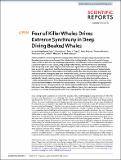Fear of killer whales drives extreme synchrony in deep diving beaked whales
Abstract
Fear of predation can induce profound changes in the behaviour and physiology of prey species even if predator encounters are infrequent. For echolocating toothed whales, the use of sound to forage exposes them to detection by eavesdropping predators, but while some species exploit social defences or produce cryptic acoustic signals, deep-diving beaked whales, well known for mass-strandings induced by navy sonar, seem enigmatically defenceless against their main predator, killer whales. Here we test the hypothesis that the stereotyped group diving and vocal behaviour of beaked whales has benefits for abatement of predation risk and thus could have been driven by fear of predation over evolutionary time. Biologging data from 14 Blainville’s and 12 Cuvier’s beaked whales show that group members have an extreme synchronicity, overlapping vocal foraging time by 98% despite hunting individually, thereby reducing group temporal availability for acoustic detection by killer whales to <25%. Groups also perform a coordinated silent ascent in an unpredictable direction, covering a mean of 1 km horizontal distance from their last vocal position. This tactic sacrifices 35% of foraging time but reduces by an order of magnitude the risk of interception by killer whales. These predator abatement behaviours have likely served beaked whales over millions of years, but may become maladaptive by playing a role in mass strandings induced by man-made predator-like sonar sounds.
Citation
Aguilar de Soto , N , Visser , F , Tyack , P L , Alcazar , J , Ruxton , G , Arranz , P , Madsen , P T & Johnson , M 2020 , ' Fear of killer whales drives extreme synchrony in deep diving beaked whales ' , Scientific Reports , vol. 10 , 13 . https://doi.org/10.1038/s41598-019-55911-3
Publication
Scientific Reports
Status
Peer reviewed
ISSN
2045-2322Type
Journal article
Description
Canary Islands: ONR grants N00014-16-1-2973 and N00014-16-1-3017, and the Spanish Central Government Plan Nacional DeepCom CTM2017-88686-P. PLT was supported by ONR grant N00014-18-1-2062 and PLT and MJ acknowledge the support of the MASTS pooling initiative (The Marine Alliance for Science and Technology for Scotland) in the completion of this study. MASTS is funded by the Scottish Funding Council (grant reference HR09011) and contributing institutions. FV and fieldwork at the Azores were supported by ONR grants N00014-15-1-2341 and N00014-17-1-2715 and by the Dutch Research Council (award number 016.Veni.181.086). NAS, PA and JA were funded for writing this paper by Ramon y Cajal, Agustín de Bethencourt and FPU grants from the Spanish Ministry and Cabildo de Tenerife, respectively.Collections
Items in the St Andrews Research Repository are protected by copyright, with all rights reserved, unless otherwise indicated.

